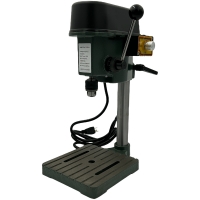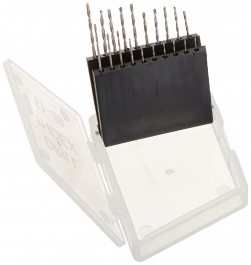- NEW DVD Series – Stone Setting with Bezels
- Tube Set Charm by Kim St. Jean
- Prong Basket Pendant by Kim St. Jean
- NEW DVD Series – Stone Setting with Cold Connections
- New DVD Series – Stone Setting with Wire
- NEW DVD Series: Introduction to Stone Setting by Kim St. Jean
- Featured Tool: Bracelet Bending Plier
- NEW Dvd by Eva Sherman
- Fun, Fast Fold Forming DVD Series
- Double Band Ear Cuff from Alex Simkin
Benchtop Drill Press
by Judy Ellis, Wire-Sculpture.com
Tool of the Week for July 21, 2014
This week’s Featured Tool is the Small Benchtop Drill Press
Do you have a drill press? Because if you don’t, you should! One of the most versatile tools on any jeweler’s bench, the drill press can do more things, more quickly, and with more precision than a lot of hand tools can.
But a new tool, especially a drill press, can be intimidating. If you are not familiar with Benchtop Drill Press then this might be a good introduction to it for you. If you are familiar with how a Drill press works, then this hopefully will be a great refresher. Let’s take a look at what the Benchtop Drill Press is and at few accessories that go hand in hand with it.
What is a “Benchtop Drill Press”?
A machine tool in which a rotating cutter, usually a twist drill, is pushed into a workpiece to produce a hole.
| Small Benchtop Drill Press
This easy-to-use benchtop drill press is very small, but powerful enough to use for all of your drilling projects. The drill press gives you better control over the speed of drilling and help you achieve “straighter” holes. You can hold the piece at the desired angle and the press will a controlled drill hole where you want it. Better control means less broken drill bits. With a platform measuring only 6-3/4″ x 6-3/4″, it is space-saving as well as economical. Variable speeds up to 8,500 RPM. 1-year warranty. |
| 20 pc. 61-80 Small Gauge Drill Bits in Metal Storage Case
Made of high-speed steel, this handy drill index offers 20 drills in sizes 61-80 (.0390″ -.0135″) for fine jobs. All drills are handily marked by size, finely ground and heat-treated to a Rockwell hardness of 63. Your small drill will stay conveniently organized in this handy metal index.
|
| Diamond Coated Uniform Shank Drills, Set of 6
Our 6 piece 3/32″ shank Swiss-made twist drills with electroplated diamond particles are the ultimate for drilling stones, pearls, glass or ceramics. Use with standard handpieces and a small amount of water as lubricant. All drills are medium-fine grit. If you are looking at the picture from left to right, the sizes are as follows:
|
To help you get started using Drill Presses- you might want to take a look at our Wire Jewelry Books. We have quite a few that will help guide you through getting started with beading and wire work. Click Here to take a look!
Happy Wrapping!

Click to Receive Daily Tips by Email






















Rosemarie Greenwald
July 21, 2014 at 7:26 am
Who manufactures the drill press you feature in this article? Cost?
Rebecca Trotman
July 21, 2014 at 7:31 am
One of the first tools my husband bought for me when I started making jewelry…LUV IT
Marcia Wisehoon
July 25, 2014 at 3:36 pm
I love my drill press! I’m still learning about different applications, but after trial and error, I’ve finally found the best drill bits for seashells. Very small (1-1.2mm), diamond coated, will go through a weathered shell in less than 15 minutes. Seashells do vary in hardness. I have been known to spend up to an hour drilling shells to keep from breaking them, but the tedium was killing me! By going smaller and diamond coated, my life is much better LOL. I do use water…I’ve taken a small plastic dish and placed a hard rubber disc (actually a furniture leg rest) so the drill bit won’t puncture the dish). I then put enough water in the dish to barely cover the shell after I place it on the rubber disc. Two fingers on the shell holds it in place. The water is important to cool and extend the life of the drill bit, to flush the hole as it is widening, and very importantly, to keep the dust down so you aren’t inhaling it. Some shell dust can be extremely dangerous — paua shell dust, I’ve heard, is like breathing glass and can damage your lungs permanently–or worse. I also place a fan to my right so that the air blows across the top of my bench, blowing any dust off to my left. I hope this isn’t TMI, but I can’t contain my enthusiasm!